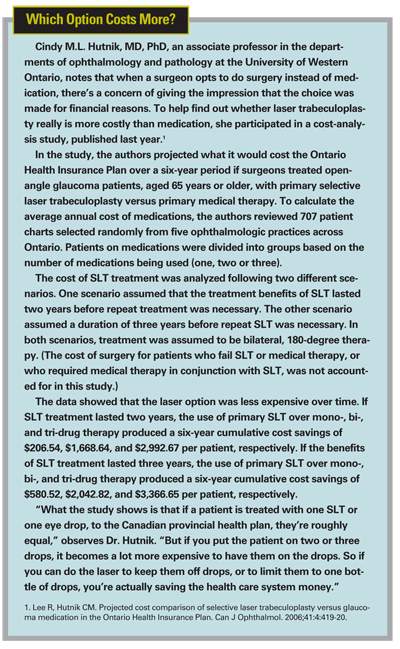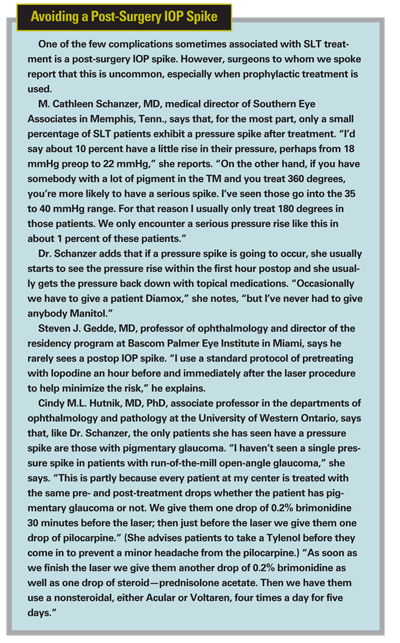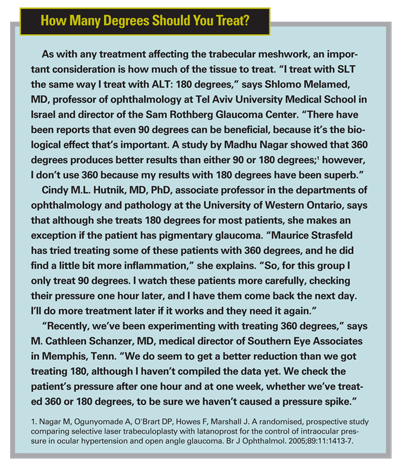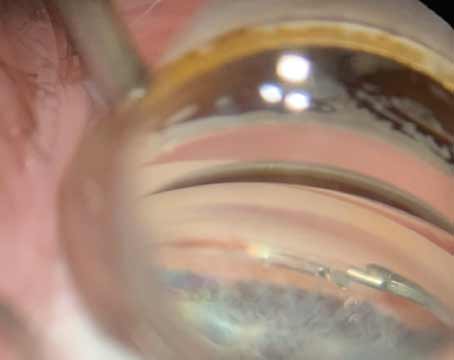As data supporting the safety and efficacy of selective laser trabeculoplasty has gradually accumulated during the past several years, the popularity of the procedure has grown. Now, many surgeons are considering using SLT as a first-line treatment for glaucoma, instead of the traditional option of prescribing drops.
To find out more about the pros and cons of this approach, we spoke to a number of surgeons who have experience using SLT as their primary therapy. (Note: None of the surgeons interviewed for this article has any financial relationship with Lumenis, manufacturer of the laser used to perform SLT.)
Opening the Door
Cindy M.L. Hutnik, MD, PhD, FRCSC, an associate professor in the departments of ophthalmology and pathology at the
"Since then, we've probably treated close to 600 patients," she continues. "Based on our experience and what's been peer-reviewed and published, we can say that SLT is safe and effective. It doesn't seem to be harmful, and the beneficial effects last at least four years in some patients."
Shlomo Melamed, MD, professor of ophthalmology at Tel Aviv University Medical School in Israel and director of the Sam Rothberg Glaucoma Center, says his group was the first to publish a study of SLT as a primary treatment for patients with ocular hypertension or open-angle glaucoma.2 "In that study we used SLT as the primary treatment on 45 eyes, and pressure came down by 30 percent," he says. "This number has been repeated in other studies done later as well, including the 2006 Canadian study that compared SLT to Xalatan." He notes that Xalatan caused about the same reduction in IOP in that study. "We've also found that 30 percent of treated patients have a pressure reduction within one hour, an observation that other investigators have confirmed. Right now we're very enthusiastic about using SLT as primary treatment."
In addition to its apparent efficacy, users list several other advantages of the procedure:
• Safety. "Of all of the patients that we've done so far, not a single one is having trouble with vision, uncontrolled pressures or inflammation," says Dr. Hutnik. "I have not seen any harmful side effects of this laser."
"The safety profile of SLT is superb," agrees Dr. Melamed. "We've seen no complications. Even the pressure spikes we sometimes see, which different studies have reported in 11 to 31 percent of patients, are very transient." (For more information on pressure spikes, see "Avoiding a Post-Surgery IOP Spike" further down.)
• It avoids compliance problems. Because the patient doesn't have to remember to purchase or instill drops, efficacy is independent of the patient's behavior. "If you suspect the patient will have a compliance problem, this is a really good way to start treatment," says Dr. Hutnik.
• It may be as effective as medication. "In general, laser trabeculoplasty is one of the few areas in which we do have clinical evidence that suggests it's as good as starting with medical therapy—at least the medical therapy we had 15 or 20 years ago," observes Dale K. Heuer, MD, professor and chairman of ophthalmology at the Medical College of Wisconsin and director of the Froedtert & Medical College of Wisconsin Eye Institute, who has been performing laser trabeculoplasty for more than 20 years. "Whether it's as good as the medical therapy we have now remains to be determined, but it's certainly safe and it avoids the problems of non-adherence to medications, which is a huge problem with topical drops."
• It may be less expensive than medications over the long run. For more on this, see "Which Option Costs More?" below.
• It doesn't prevent future canal-related procedures. "I've now switched from ALT to SLT," says Dr. Heuer, "primarily because I'm hopeful that within the next five years or so we'll be able to treat glaucoma with an incisional technique that works on Schlemm's canal. Unlike ALT, SLT is gentle to the canal. It doesn't complicate potential future options."
• It may mitigate higher nocturnal IOP. "A paper just published in Ophthalmology3 reports data indicating that SLT helps to blunt the natural pressure rise that occurs when we sleep," notes Dr. Heuer. "Some medications don't do that."
Primary Treatment or Adjunct?
One argument for using SLT as a first-line treatment is that it appears to be more efficacious in a virgin eye. Dr. Hutnik notes that in some studies of its effectiveness, SLT is used as an adjunct; those studies often report that the effect only lasts six months. "On a virgin eye you can get a pressure reduction of 30 percent from baseline," she says. "That's just as good as any current medication on the market. But if the patient is already on treatment, the best you'll get is about a 20-percent reduction. And the more drops the patient is on, the less effective SLT is." (She notes, however, that even in this situation the patient may benefit by needing to use fewer drops.)
Asked to explain this difference in pressure reduction, Dr. Hutnik hypothesizes that the trabecular meshwork is altered by the medication. "In fact," she says, "I send patients home on a nonsteroidal anti-inflammatory because there have been reports that a steroid interferes with the pressure-lowering effect and patients don't do quite as well. So at a molecular level, there's something going on with the drugs and the meshwork and what the laser is doing."
M.
Retreatment Issues
One reason sometimes given for not using laser trabeculoplasty as a first-line option is that the beneficial effect often diminishes over time. However, because SLT doesn't cause the kind of collateral tissue damage caused by ALT, it may be safe to use more than once on a patient. Several of the surgeons we spoke with have performed SLT multiple times on patients with good results. (Unfortunately, no clinical studies have yet confirmed the safety of doing this.)
"I've only had to repeat SLT in a few patients," says Dr. Melamed. "We've found that retreating can be very beneficial, and studies have supported this. The improvement may be less than that produced by the original treatment, but it's still worthwhile because of the safety profile."
"How long the pressure stays acceptably low has not been consistent between patients," notes Dr. Schanzer, who has also retreated many individuals. "We bring some patients back for retreatment after a year; others are three years out and haven't needed any retreatment. My gut feeling is that the earlier we treat, the longer the response lasts, but I don't yet have data to confirm that.
"Patients don't seem to mind that they might need retreatment," she adds. "This is a procedure their insurance will cover, and except for using a nonsteroidal for a few days, they're pretty much done with drops. They don't have to worry about getting to the pharmacy every month. They just come in every three or four months so we can check their pressure and monitor the nerve fiber layer and visual field."
Dr. Hutnik observes that in the initial ALT data, about 50 percent of patients needed retreatment at five years. "With SLT, we're almost to the four-year data mark, and I suspect the data will be similar," she says. "I have some patients for whom one treatment has lasted four years, and others for whom one treatment has lasted about two years. I think it has to do with what's clogging up the drain. Ultimately we just have to wait for the long-term studies to find out what happens after 5 or 10 years."
She does note that the treatment seems to not last as long when the patient has pigment-dispersion glaucoma. "In this situation SLT cleans the drain out, but the pigment continues to be dispersed, so it clogs back up," she says. "You're more likely to do a repeat SLT on these patients."
The Arguments for Waiting
Despite the many points in its favor, SLT is only slowly being adopted by the community at large, especially as a first-line option. Steven J. Gedde, MD, professor of ophthalmology and director of the residency program at Bascom Palmer Eye Institute in
There are several possible explanations:
• Lack of long-term data. "SLT is relatively a new guy on the block," observes Dr. Hutnik. "By way of comparison, the first prostaglandin was introduced in 1996, so we have 10 years of published data on it. With SLT, I was uncomfortable at first, but as each day goes by I'm getting more comfortable. Hopefully the five-year data will be coming out soon."
• Medications work very well. "In many cases we can control glaucoma with one medication used once a day," says Dr. Gedde. "Given that profile, even a minimally invasive procedure like laser treatment may be less desirable." Nevertheless, he observes that there are several points in SLT's favor, including efficacy, safety, cost over the long run and avoiding compliance issues. "Also, there may be a psychological cost to using medical therapy on a daily basis," he notes. "It acts as a constant reminder that you have a disease process."
Dr. Melamed says that in his experience, SLT is more like a medical treatment than a surgical procedure anyway. "It doesn't involve any cutting or traction, or anything that would be considered surgical," he points out. "It only impacts the trabecular meshwork cells containing pigment—which is why it's called selective—and it initiates a cascade of events that are mainly biological. So to me it is like medical treatment, except that it is delivered directly to the TM."
• Lack of reversibility. Dr. Heuer notes that medical therapy appears to be completely reversible, which SLT is not. "The counterpoint to that, however, is that the complication rate from laser trabeculoplasty is extraordinarily small," he says. "As a result, that concern doesn't hold a lot of weight."
• Cost of another laser. "Many ophthalmologists already have an ALT laser," notes Dr. Melamed, "and it hasn't been demonstrated that SLT is better than ALT in terms of efficacy. Why buy another laser when no difference has been demonstrated?"
But Dr. Schanzer notes that the apparent ability to re-treat makes a big difference. "We've used the SLT laser a lot," she says. "With the argon laser we hated to re-treat because of concerns about damaging the meshwork."
• Sticking with tradition. "Our training has always been medication first and surgery second, including laser surgery, and that's what's accepted in the community," notes Dr. Schanzer. "We've gotten used to it."
"Changing our approach to treatment takes time, even with a very successful procedure," agrees Dr. Melamed. "Nevertheless, more people are using SLT and more papers about it are appearing in the literature."
Will SLT Replace Medications?
Despite their positive experience with SLT, all of our surgeons said they wouldn't rush to suggest dropping medications as a first-line option. "Eye drops are safe and effective, and they are part of the traditional treatment paradigm, so they should be offered as an option to the patient," says Dr. Hutnik. "At the moment, we don't know if SLT wears off sooner than the first-line drug. But we also don't know what the cumulative effect of putting medications on an eye for many years will be."
"I think you should offer both to your patients with some discussion of their advantages and disadvantages," says Dr. Gedde. "Let the patients be very involved in the decision about what will work best for them. Some people are very put off by the idea of any invasive procedure, even a minimally invasive one such as laser treatment. Others are very interested in avoiding chronic medical therapy."
Whether or not SLT will ever replace medications as a first-line therapy, it's clear that it's coming on strong as a primary treatment option. "If you're 55 years old and I can delay your needing eye drops until you're 65, I'm doing you a favor," says Dr. Hutnik. "Even if you're very compliant, I'm saving you some money and I'm not exposing your eyes to the side effects of the medications."
Dr. Melamed adds that drugs have potential complications. "You have to take them continuously for life, and the cost is ongoing," he notes. "I'm not suggesting medical treatment should be eliminated, but given that SLT is at least as effective as medical treatment, has an almost 100-percent safety profile, and almost certainly costs less over time even with repeated treatment, I think it should definitely be considered as a primary procedure."
What's Next?
Currently, surgeons and researchers are working to answer some of the remaining questions that may help maximize SLT's effectiveness. One study, designed to identify factors that might predict greater IOP reduction after SLT in ocular hypertension and open-angle glaucoma patients, was profiled at this year's Association for Research in Vision and Ophthalmology meeting (A. J. Mao AJ et al. IOVS 2007;48:E-Abstract 3978.) Data from 220 patients showed that SLT efficacy was positively associated with IOP elevation prior to laser treatment and adversely associated with the maximum IOP ever recorded in the patient's history. There was no connection between efficacy and pigmentation of the anterior chamber angle.
Other researchers are investigating whether SLT is more effective in some situations than others. "My feeling is that SLT is more effective with certain glaucomas," says Dr. Hutnik, "and it probably works better in conjunction with some classes of medication." She says her group is currently analyzing data in hopes of shedding light on both of these possibilities.
1. McIlraith I, Strasfeld M, Colev G, Hutnik CM. Selective laser trabeculoplasty as initial and adjunctive treatment for open-angle glaucoma. J Glaucoma 2006;15:2:124-30.
2. Melamed S, Ben Simon GJ, Levkovitch-Verbin H. Selective laser trabeculoplasty as primary treatment for open-angle glaucoma: A prospective, nonrandomized pilot study. Arch Ophthalmol. 2005;123:1:127.
3. Lee AC, Mosaed S, Weinreb RN, Kripke DF, Liu JHK. Effect of Laser Trabeculoplasty on Nocturnal Intraocular Pressure in Medically Treated Glaucoma Patients. Ophthalmology 2007;114:4:666-670.
4. The Glaucoma Laser Trial Research Group. The Glaucoma Laser Trial (GLT): 2. Results of argon laser trabeculoplasty versus topical medicines. Ophthalmology. 1990; 97:11:1403-13.




